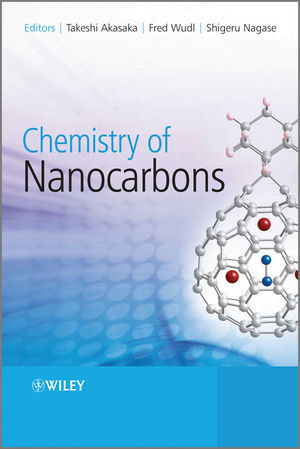Chemistry of NanocarbonsISBN: 978-0-470-72195-7
Hardcover
526 pages
July 2010
 |
||||||
Acknowledgements.
Contributors.
Abbreviations.
1 Noncovalent Functionalization of Carbon Nanotubes (Claudia Backes and Andreas Hirsch).
1.1 Introduction.
1.2 Overview of Functionalization Methods.
1.3 The Noncovalent Approach.
1.4 Conclusion.
2 Supramolecular Assembly of Fullerenes and Carbon Nanotubes Hybrids (Ma Angeles Herranz, Beatriz M. Illescas, Emilio M. Perez and Nazario Martın).
2.1 Introduction,
2.2 Hydrogen Bonded C60-Donor Ensembles.
2.3 Concave exTTF Derivatives as Recognizing Motifs for Fullerene.
2.4 Noncovalent Functionalization of Carbon Nanotubes.
2.5 Summary and Outlook.
3 Properties of Fullerene-Containing Dendrimers (Juan-Jose Cid Martin and Jean-Francois Nierengarten).
3.1 Introduction.
3.2 Dendrimers with a Fullerene Core.
3.3 Fullerene-Rich Dendrimers.
3.4 Conclusions.
4 Novel Electron Donor Acceptor Nanocomposites (Hiroshi Imahori, Dirk M. Guldi and Shunichi Fukuzumi).
4.1 Introduction.
4.2 Electron Donor-Fullerene Composites.
4.3 Carbon Nanotubes.
4.4 Other Nanocarbon Composites.
5 Higher Fullerenes: Chirality and Covalent Adducts (Agnieszka Kraszewska, Franc¸ois Diederich and Carlo Thilgen).
5.1 Introduction.
5.2 The Chemistry of C70.
5.3 The Higher Fullerenes Beyond C70.
5.4 Concluding Remarks.
6 Application of Fullerenes to Nanodevices (Yutaka Matsuo and Eiichi Nakamura).
6.1 Introduction.
6.2 Synthesis of Transition Metal Fullerene Complexes.
6.3 Organometallic Chemistry of Metal Fullerene Complexes.
6.4 Synthesis of Multimetal Fullerene Complexes.
6.5 Supramolecular Structures of Penta(organo)[60]fullerene Derivatives.
6.6 Reduction of Penta(organo)[60]fullerenes to Generate Polyanions.
6.7 Photoinduced Charge Separation.
6.8 Photocurrent-Generating Organic and Organometallic Fullerene Derivatives.
6.9 Conclusion.
7 Supramolecular Chemistry of Fullerenes: Host Molecules for Fullerenes on the Basis of p-p Interaction (Takeshi Kawase).
7.1 Introduction.
7.2 Fullerenes as an Electron Acceptor.
7.3 Host Molecules Composed of Aromatic p-systems.
7.4 Complexes with Host Molecules Based on Porphyrin p Systems.
7.5 Complexes with Host Molecules Bearing a Cavity Consisting of Curved p System.
7.6 The Nature of the Supramolecular Property of Fullerenes.
8 Molecular Surgery toward Organic Synthesis of Endohedral Fullerenes (Michihisa Murata, Yasujiro Murata and Koichi Komatsu)
8.1 Introduction.
8.2 Molecular-Surgery Synthesis of Endohedral C60 Encapsulating Molecular Hydrogen.
8.3 Chemical Functionalization of H2@C60.
8.4 Utilization of the Encapsulated H2 as an NMR Probe.
8.5 Physical Properties of an Encapsulated H2 in C60.
8.6 Molecular-Surgery Synthesis of Endohedral C70 Encapsulating Molecular Hydrogen.
8.7 Outlook.
9 New Endohedral Metallofullerenes: Trimetallic Nitride Endohedral Fullerenes (Marilyn M. Olmstead, Alan L. Balch, Julio R. Pinzon, Luis Echegoyen, Harry W. Gibson and Harry C. Dorn).
9.1 Discovery, Preparation, and Purification.
9.2 Structural Studies.
9.3 Summary and Conclusions.
10 Recent Progress in Chemistry of Endohedral Metallofullerenes (Takahiro Tsuchiya, Takeshi Akasaka and Shigeru Nagase).
10.1 Introduction.
10.2 Chemical Derivatization of Mono-Metallofullerenes.
10.3 Chemical Derivatization of Di-Metallofullerenes.
10.4 Chemical Derivatization of Trimetallic Nitride Template Fullerene.
10.5 Chemical Derivatization of Metallic Carbaide Fullerene.
10.6 Missing Metallofullerene.
10.7 Supramolecular Chemistry.
10.8 Conclusion.
11 Gadonanostructures as Magnetic Resonance Imaging Contrast Agents (Jeyarama S. Ananta and Lon J. Wilson).
11.1 Magnetic Resonance Imaging (MRI) and the Role of Contrast Agents (CAs).
11.2 The Advantages of Gadonanostructures as MRI Contrast Agent Synthons.
11.3 Gadofullerenes as MRI Contrast Agents.
11.4 Understanding the Relaxation Mechanism of Gadofullerenes.
11.5 Gadonanotubes as MRI Contrast Agents.
12 Chemistry of Soluble Carbon Nanotubes: Fundamentals and Applications (Tsuyohiko Fujigaya and Naotoshi Nakashima).
12.1 Introduction.
12.2 Characterizations of Dispersion States.
12.3 CNT Solubilization by Small Molecules.
12.4 Solubilization by Polymers.
12.5 Nanotube/Polymer Hybrids and Composites.
12.6 Summary.
13 Functionalization of Carbon Nanotubes for Nanoelectronic and Photovoltaic Applications (Stephane Campidelli and Maurizio Prato).
13.1 Introduction.
13.2 Functionalization of Carbon Nanotubes.
13.3 Properties and Applications.
13.4 Conclusion.
14 Dispersion and Separation of Single-walled Carbon Nanotubes (Yutaka Maeda, Takeshi Akasaka, Jing Lu and Shigeru Nagase).
14.1 Introduction.
14.2 Dispersion of SWNTs.
14.3 Purification and Separation of SWNTs Using Amine.
14.4 Conclusion.
15 Molecular Encapsulations into Interior Spaces of Carbon Nanotubes and Nanohorns (T. Okazaki, S. Iijima and M. Yudasaka).
15.1 Introduction.
15.2 SWCNT Nanopeapods.
15.3 Material Incorporation and Release in/from SWNH.
15.4 Summary.
16 Carbon Nanotube for Imaging of Single Molecules in Motion (Eiichi Nakamura).
16.1 Introduction.
16.2 Electron Microscopic Observation of Small Molecules.
16.3 TEM Imaging of Alkyl Carborane Molecules.
16.4 Alkyl Chain Passing through a Hole.
16.5 3D Structural Information on Pyrene Amide Molecule.
16.6 Complex Molecule 4 Fixed outside of Nanotube.
16.7 Conclusion.
17 Chemistry of Single-Nano Diamond Particles (Eiji Osawa).
17.1 Introduction.
17.2 Geometrical Structure.
17.3 Electronic Structure.
17.4 Properties.
17.5 Applications.
17.6 Recollection and Perspectives.
18 Properties of p-electrons in Graphene Nanoribbons and Nanographenes (De-en Jiang, Xingfa Gao, Shigeru Nagase and Zhongfang Chen).
18.1 Introduction.
18.2 Edge Effects in Graphene Nanoribbons and Nanographenes.
18.3 Electronic and Magnetic Properties of Graphene Nanoribbons and Nanographenes.
18.4 Outlook.
19 Carbon Nano Onions (Luis Echegoyen, Angy Ortiz, Manuel N. Chaur and Amit J. Palkar).
19.1 Introduction.
19.2 Physical Properties of Carbon Nano Onions Obtained from Annealing.
19.3 Raman Spectroscopy of Carbon Nano Onions Prepared by Annealing Nanodiamonds.
19.4 Electron Paramagnetic Resonance Spectroscopy.
19.5 Carbon Nano Onions Prepared from Arcing Graphite Underwater.
19.6 Reactivity of Carbon Nano Onions (CNOs).
19.7 Potential Applications of CNOs.
Acknowledgements.
References.
Index.



